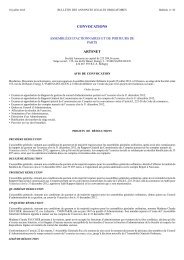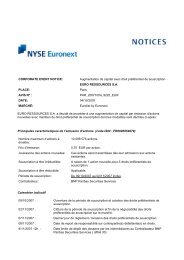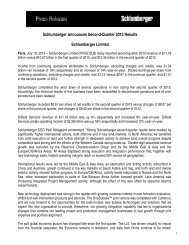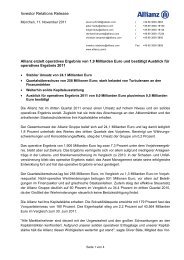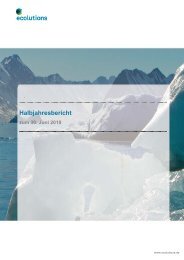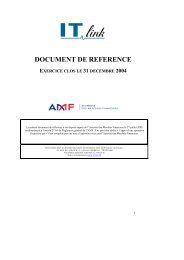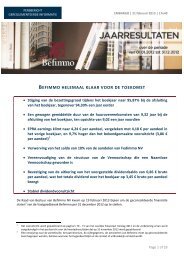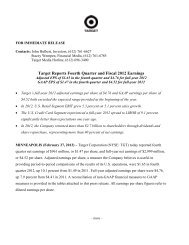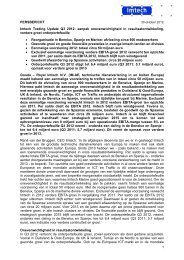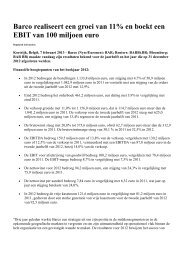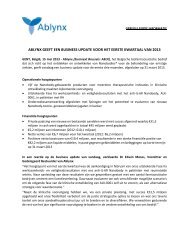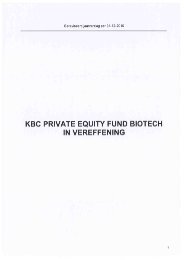2006 Annual Report
2006 Annual Report
2006 Annual Report
You also want an ePaper? Increase the reach of your titles
YUMPU automatically turns print PDFs into web optimized ePapers that Google loves.
previously deferred and recognize the corresponding expense<br />
relating to the costs of the awards redeemed.<br />
Valuation of Goodwill<br />
We evaluate the fair value of goodwill to assess potential impairments<br />
on an annual basis, or during the year if an event or other<br />
circumstance indicates that we may not be able to recover the<br />
carrying amount of the asset. We evaluate the fair value of goodwill<br />
at the reporting unit level and make that determination<br />
based upon future cash flow projections that assume certain<br />
growth projections which may or may not occur. We record an<br />
impairment loss for goodwill when the carrying value of the<br />
intangible asset is less than its estimated fair value.<br />
Loan Loss Reserves<br />
Lodging Senior Loans and Lodging Mezzanine and Other Loans<br />
We measure loan impairment based on the present value of<br />
expected future cash flows discounted at the loan’s original effective<br />
interest rate or the estimated fair value of the collateral. For<br />
impaired loans, we establish a specific impairment reserve for the<br />
difference between the recorded investment in the loan and the<br />
present value of the expected future cash flows, that assumes certain<br />
growth projections which may or may not occur, or the estimated<br />
fair value of the collateral. We apply our loan impairment<br />
policy individually to all loans in the portfolio and do not aggregate<br />
loans for the purpose of applying such policy. Where we<br />
determine that a loan is impaired, we recognize interest income<br />
on a cash basis. At year-end <strong>2006</strong>, our recorded investment in<br />
impaired loans was $92 million. We had a $70 million allowance<br />
for credit losses, leaving $22 million of our investment in impaired<br />
loans for which there was no related allowance for credit losses.<br />
At year-end 2005, our recorded investment in impaired loans was<br />
$184 million. We had a $103 million allowance for credit losses,<br />
leaving $81 million of our investment in impaired loans for which<br />
there was no related allowance for credit losses. During <strong>2006</strong> and<br />
2005, our average investment in impaired loans totaled $138 million<br />
and $182 million, respectively.<br />
Loans to Timeshare Owners<br />
In conjunction with the adoption of SOP 04-2, we now record an<br />
estimate of expected uncollectibility on notes receivable that we<br />
receive from timeshare purchasers as a reduction of revenue at<br />
the time we recognize profit on a timeshare sale. We assess<br />
uncollectibility based on pools of receivables, because we hold<br />
large numbers of homogenous timeshare notes receivable. We<br />
estimate uncollectibles based on historical uncollectibles for<br />
similar timeshare notes receivable over the past six years. We<br />
use a technique referred to as static pool analysis, which tracks<br />
uncollectibles for each year’s sales over the life of those notes.<br />
At year-end <strong>2006</strong>, our allowance for credit losses associated with<br />
“Loans to timeshare owners” totaled $29 million.<br />
Legal Contingencies<br />
We are subject to various legal proceedings and claims, the outcomes<br />
of which are subject to significant uncertainty. We record<br />
an accrual for loss contingencies when a loss is probable and<br />
the amount of the loss can be reasonably estimated. We review<br />
these accruals each reporting period and make revisions based<br />
on changes in facts and circumstances.<br />
Income Taxes<br />
We record the current year amounts payable or refundable, as well<br />
as the consequences of events that give rise to deferred tax assets<br />
and liabilities based on differences in how those events are treated<br />
for tax purposes.We base our estimate of deferred tax assets and<br />
liabilities on current tax laws and rates and, in certain cases,<br />
business plans and other expectations about future outcomes.<br />
Changes in existing laws and rates, and their related interpretations,<br />
and future business results may affect the amount of<br />
deferred tax liabilities or the valuation of deferred tax assets<br />
over time. Our accounting for deferred tax consequences represents<br />
management’s best estimate of future events that can be<br />
appropriately reflected in the accounting estimates.<br />
OTHER MATTERS<br />
Inflation<br />
Inflation has been moderate in recent years and has not had a<br />
significant impact on our businesses.<br />
QUANTITATIVE AND QUALITATIVE DISCLOSURES<br />
ABOUT MARKET RISK.<br />
We are exposed to market risk from changes in interest rates,<br />
foreign exchange rates, and debt and equity prices, and for our<br />
synthetic fuel business, oil prices. We manage our exposure to<br />
these risks by monitoring available financing alternatives,<br />
through development and application of credit granting policies<br />
and by entering into derivative arrangements. We do not foresee<br />
any significant changes in either our exposure to fluctuations in<br />
interest rates or foreign exchange rates or how such exposure is<br />
managed in the future.<br />
We are exposed to interest rate risk on our floating-rate notes<br />
receivable, our residual interests retained in connection with the<br />
sale of Timeshare segment notes receivable and the fair value of<br />
our fixed-rate notes receivable.<br />
Changes in interest rates also impact our floating-rate longterm<br />
debt and the fair value of our fixed-rate long-term debt.<br />
We are also subject to risk from changes in debt and equity<br />
prices from our investments in debt securities and common<br />
stock, which have a carrying value of $107 million at year-end<br />
<strong>2006</strong> and are accounted for as available-for-sale securities under<br />
FAS No. 115,“Accounting for Certain Investments in Debt and<br />
Equity Securities.”<br />
We use derivative instruments as part of our overall strategy<br />
to manage our exposure to market risks associated with fluctuations<br />
in interest rates and foreign currency exchange rates. As a<br />
matter of policy, we do not use derivatives for trading or speculative<br />
purposes.<br />
At year-end <strong>2006</strong> we were party to the following derivative<br />
instruments:<br />
3 An interest rate swap agreement under which we receive<br />
a floating rate of interest and pay a fixed rate of interest.<br />
The swap modifies our interest rate exposure by effectively<br />
converting a note receivable with a fixed rate to a<br />
floating rate. The aggregate notional amount of the swap<br />
was $92 million and it matures in 2010.<br />
3 Four outstanding interest rate swap agreements to manage<br />
interest rate risk associated with the residual interests<br />
we retain in conjunction with our timeshare note sales.<br />
Historically, we were required by purchasers and/or rating<br />
agencies to utilize interest rate swaps to protect the<br />
excess spread within our sold note pools. The aggregate<br />
notional amount of the swaps was $209 million, and they<br />
expire through 2022.<br />
3 Option contracts to hedge the potential volatility of<br />
earnings and cash flows associated with variations in<br />
foreign exchange rates during 2007. The aggregate dollar<br />
equivalent of the notional amounts of the contracts was<br />
approximately $47 million, and they expire throughout 2007.<br />
MARRIOTT INTERNATIONAL, INC. <strong>2006</strong> | 35



